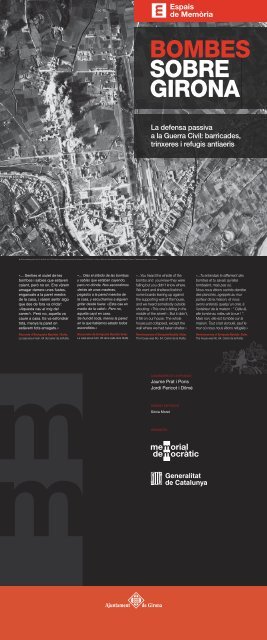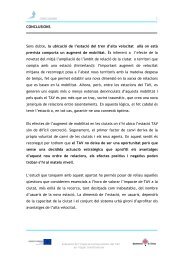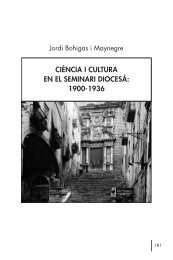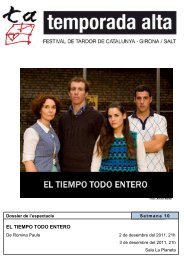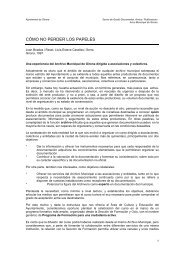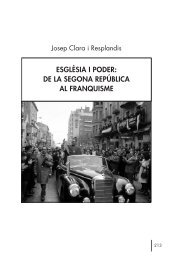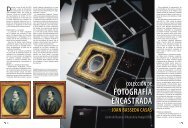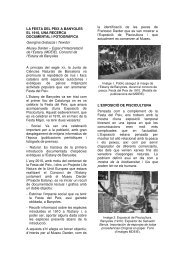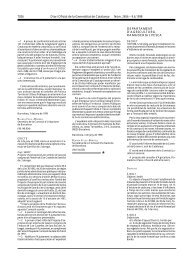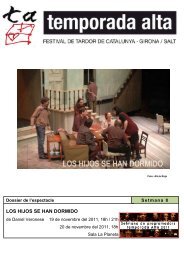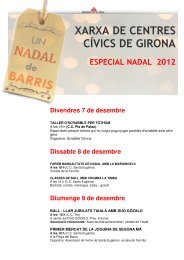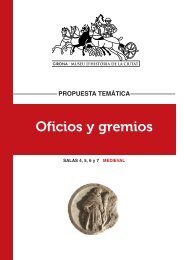La defensa passiva a la Guerra Civil - Ajuntament de Girona
La defensa passiva a la Guerra Civil - Ajuntament de Girona
La defensa passiva a la Guerra Civil - Ajuntament de Girona
You also want an ePaper? Increase the reach of your titles
YUMPU automatically turns print PDFs into web optimized ePapers that Google loves.
Bombar<strong>de</strong>ig <strong>de</strong>l dia 20 d’abril <strong>de</strong> 1938 sobre <strong>la</strong> part meridional <strong>de</strong> <strong>Girona</strong>. FOTOGRAFIA: Ufficio Storico <strong>de</strong>ll’Aeronautica Militare, Roma. Cedida per Diari <strong>de</strong> <strong>Girona</strong>.<br />
«... Senties el xiulet <strong>de</strong> les<br />
bombes i sabies que estaven<br />
caient, però no on. Ens vàrem<br />
amagar darrere unes fustes,<br />
enganxats a <strong>la</strong> paret mestra<br />
<strong>de</strong> <strong>la</strong> casa, i vàrem sentir algú<br />
que <strong>de</strong>s <strong>de</strong> fora va cridar:<br />
«Aquesta cau al mig <strong>de</strong>l<br />
carrer!». Però no, aquel<strong>la</strong> va<br />
caure a casa. Es va esfondrar<br />
tota, menys <strong>la</strong> paret on<br />
estàvem tots amagats.»<br />
Records d’Enriqueta Baulida i Soler.<br />
<strong>La</strong> casa era el núm. 64 <strong>de</strong>l carrer <strong>de</strong> <strong>la</strong> Rutl<strong>la</strong>.<br />
«... Oías el silbido <strong>de</strong> <strong>la</strong>s bombas<br />
y sabías que estaban cayendo,<br />
pero no dón<strong>de</strong>. Nos escondimos<br />
<strong>de</strong>trás <strong>de</strong> unas ma<strong>de</strong>ras,<br />
pegados a <strong>la</strong> pared maestra <strong>de</strong><br />
<strong>la</strong> casa, y escuchamos a alguien<br />
gritar <strong>de</strong>s<strong>de</strong> fuera: «¡Esta cae en<br />
medio <strong>de</strong> <strong>la</strong> calle!». Pero no,<br />
aquel<strong>la</strong> cayó en casa.<br />
Se hundió toda, menos <strong>la</strong> pared<br />
en <strong>la</strong> que habíamos estado todos<br />
escondidos.»<br />
Recuerdos <strong>de</strong> Enriqueta Baulida Soler.<br />
<strong>La</strong> casa era el núm. 64 <strong>de</strong> <strong>la</strong> calle <strong>de</strong> <strong>la</strong> Rutl<strong>la</strong>.<br />
BOMBES<br />
SOBRE<br />
GIRONA<br />
<strong>La</strong> <strong><strong>de</strong>fensa</strong> <strong>passiva</strong><br />
a <strong>la</strong> <strong>Guerra</strong> <strong>Civil</strong>: barrica<strong>de</strong>s,<br />
trinxeres i refugis antiaeris<br />
«...You heard the whistle of the<br />
bombs and you knew they were<br />
falling but you didn’t know where.<br />
We went and sheltered behind<br />
some boards leaning up against<br />
the supporting wall of the house,<br />
and we heard somebody outsi<strong>de</strong><br />
shouting: «This one’s falling in the<br />
middle of the street!». But it didn’t,<br />
it fell on our house. The whole<br />
house just col<strong>la</strong>psed, except the<br />
wall where we had taken shelter.»<br />
Reminiscences of Enriqueta Baulida i Soler.<br />
The house was No. 64, Carrer <strong>de</strong> <strong>la</strong> Rutl<strong>la</strong>.<br />
COMISSARIS DE L’EXPOSICIÓ<br />
Jaume Prat i Pons<br />
Jordi Pericot i Dilmé<br />
DISSENY EXPOSICIÓ<br />
Sònia Moret<br />
ORGANITZA<br />
«...Tu entendais le sifflement <strong>de</strong>s<br />
bombes et tu savais qu’elles<br />
tombaient, mais pas où.<br />
Nous nous étions cachés <strong>de</strong>rrière<br />
<strong>de</strong>s p<strong>la</strong>nches, agrippés au mur<br />
porteur <strong>de</strong> <strong>la</strong> maison, et nous<br />
avons entendu quelqu’un crier, à<br />
l’extérieur <strong>de</strong> <strong>la</strong> maison : “ Celle-là,<br />
elle tombe au milieu <strong>de</strong> <strong>la</strong> rue ! ”.<br />
Mais non, elle est tombée sur <strong>la</strong><br />
maison. Tout s’est écroulé, sauf le<br />
mur où nous nous étions réfugiés.»<br />
Reminiscences of Enriqueta Baulida i Soler.<br />
The house was No. 64, Carrer <strong>de</strong> <strong>la</strong> Rutl<strong>la</strong>.
<strong>La</strong> <strong>Guerra</strong> <strong>Civil</strong> (1936-1939)<br />
En el context d’una greu crispació social i una radicalització política<br />
marcada, el dia 17 <strong>de</strong> juliol <strong>de</strong> 1936 les tropes colonials <strong>de</strong>l<br />
Marroc es revoltaren contra el legítim Govern <strong>de</strong> <strong>la</strong> República.<br />
L’en<strong>de</strong>mà, dia 18 <strong>de</strong> juliol, el general Francisco Franco proc<strong>la</strong>mà<br />
per ràdio, <strong>de</strong>s <strong>de</strong> Tenerife, l’estat <strong>de</strong> guerra i <strong>la</strong> rebel·lió es va escampar<br />
a nombrosos cossos <strong>de</strong> l’Exèrcit <strong>de</strong> tota <strong>la</strong> Penínsu<strong>la</strong>.<br />
L’objectiu <strong>de</strong>ls militars revoltats era que el cop d’estat durés tres o<br />
quatre dies, però el fet que només triomfessin <strong>de</strong> manera parcial a<br />
<strong>la</strong> Penínsu<strong>la</strong> fou el <strong>de</strong>tonant que provocà l’esc<strong>la</strong>t <strong>de</strong> <strong>la</strong> <strong>Guerra</strong> <strong>Civil</strong><br />
i <strong>de</strong> tot allò que vingué a continuació fins a <strong>la</strong> seva fi, l’1 d’abril <strong>de</strong><br />
1939. Durant aquests tres anys, tant al camp <strong>de</strong> batal<strong>la</strong> com en <strong>la</strong><br />
in<strong><strong>de</strong>fensa</strong> rereguarda, <strong>la</strong> violència fou <strong>la</strong> gran protagonista.<br />
<strong>La</strong> <strong>Guerra</strong> <strong>Civil</strong> (1936-1939)<br />
El 17 <strong>de</strong> julio <strong>de</strong> 1936, en un contexto <strong>de</strong> grave crispación social<br />
y marcada radicalización política, <strong>la</strong>s tropas coloniales <strong>de</strong> Marruecos<br />
se s ublevaron contra el legítimo Gobierno <strong>de</strong> <strong>la</strong> República.<br />
Al día siguiente, 18 <strong>de</strong> julio, el general Francisco Franco<br />
proc<strong>la</strong>mó por radio, <strong>de</strong>s<strong>de</strong> Tenerife, el estado <strong>de</strong> guerra y <strong>la</strong> rebelión<br />
se extendió a numerosos cuerpos <strong>de</strong>l Ejército <strong>de</strong> toda <strong>la</strong><br />
Penínsu<strong>la</strong>. El objetivo <strong>de</strong> los militares sublevados era dar un<br />
golpe <strong>de</strong> Estado que durara únicamente tres o cuatro días, pero<br />
su triunfo solo parcial en <strong>la</strong> Penínsu<strong>la</strong> fue el <strong>de</strong>tonante que provocó<br />
el estallido <strong>de</strong> <strong>la</strong> <strong>Guerra</strong> <strong>Civil</strong> y <strong>de</strong> todo lo que vino a continuación<br />
hasta el final <strong>de</strong> <strong>la</strong> contienda, el 1 <strong>de</strong> abril <strong>de</strong> 1939. Durante<br />
estos tres años, tanto en el campo <strong>de</strong> batal<strong>la</strong> como en <strong>la</strong><br />
in<strong><strong>de</strong>fensa</strong> retaguardia, <strong>la</strong> violencia fue <strong>la</strong> gran protagonista.<br />
The Spanish <strong>Civil</strong> War (1936-1939)<br />
On 17 July 1936, against a background of serious social unrest and<br />
notable political radicalisation, the military stationed in the Spanish<br />
Protectorate in Morocco revolted against the legitimate Second Republic<br />
government. The following day, speaking on the radio from<br />
Tenerife, General Francisco Franco proc<strong>la</strong>imed a state of war, thereby<br />
spreading the rebellion to many other sectors of the army on the<br />
Spanish main<strong>la</strong>nd. The military insurgents envisaged a coup d’état<br />
<strong>la</strong>sting for three or four days, but the revolt only met with partial success<br />
on the main<strong>la</strong>nd. This triggered off the Spanish <strong>Civil</strong> War and<br />
all the following tragic events which ensued. The war en<strong>de</strong>d on 1<br />
April 1939, and during those three years violence raged both on the<br />
battlefield and in the <strong>de</strong>fenceless non-combat zones.<br />
<strong>La</strong> Guerre <strong>Civil</strong>e (1936-1939)<br />
Le 17 juillet 1936, dans un contexte <strong>de</strong> grave crispation sociale et <strong>de</strong><br />
radicalisation politique accusée, les troupes coloniales du Maroc se<br />
révoltent contre le gouvernement légitime <strong>de</strong> <strong>la</strong> République. Sur les<br />
on<strong>de</strong>s, le len<strong>de</strong>main 18 juillet, le général Francisco Franco proc<strong>la</strong>me<br />
l’état <strong>de</strong> guerre <strong>de</strong>puis l’île <strong>de</strong> Tenerife, et <strong>la</strong> rébellion s’étend à <strong>de</strong><br />
nombreux corps d’armée dans tous le pays. L’objectif <strong>de</strong>s militaires<br />
insurgés est <strong>de</strong> faire durer le coup d’état trois ou quatre jours, mais le<br />
succès partiel rencontré par l’insurrection dans <strong>la</strong> Péninsule sera le<br />
détonateur qui déclenchera <strong>la</strong> Guerre <strong>Civil</strong>e et tout ce qui s’en suivra,<br />
jusqu’à <strong>la</strong> fin du conflit, le 1er avril 1939. Durant ces trois années,<br />
aussi bien sur le front qu’à l’arrière sans défense, <strong>la</strong> violence sera le<br />
principal protagoniste.<br />
1<br />
2<br />
4<br />
1.<br />
Creuer franquista Canarias,<br />
responsable <strong>de</strong>l primer<br />
bombar<strong>de</strong>ig (per mar) a les<br />
comarques gironines.<br />
Crucero franquista<br />
Canarias, responsable <strong>de</strong>l<br />
primer bombar<strong>de</strong>o (por mar)<br />
en <strong>la</strong>s comarcas gerun<strong>de</strong>nses.<br />
Franco’s cruiser Canarias,<br />
from which the first (naval)<br />
bomb attack was <strong>la</strong>unched<br />
against <strong>Girona</strong> province.<br />
Croiseur franquiste Canarias,<br />
responsable du premier<br />
bombar<strong>de</strong>ment (par mer) sur<br />
<strong>la</strong> région <strong>de</strong> Gérone.<br />
(EXTRETA / EXTRAÍDA / FROM / TIRÉE:<br />
http://funkoffizier.wordpress.com/<br />
2007/03/28/crucero-c-21-canarias/)<br />
2.<br />
Nens fent <strong>la</strong><br />
salutació feixista.<br />
Niños haciendo<br />
el saludo fascista.<br />
Children giving the<br />
fascist salute.<br />
Enfants faisant le<br />
salut fasciste.<br />
(PROCEDÈNCIA /<br />
PROCEDENCIA / SOURCE /<br />
SOURCE: Agència EFE)<br />
El general Camilo Alonso Vega, <strong>de</strong>sfi<strong>la</strong>nt victoriós per l’actual ramb<strong>la</strong> <strong>de</strong> <strong>la</strong> Llibertat al capdavant <strong>de</strong> les tropes franquistes. FOTOGRAFIA: FOTOS, Semanario Gráfico Nacionalsindicalista, núm. 103.<br />
3<br />
3.<br />
Estralls causats per<br />
<strong>la</strong> <strong>Guerra</strong> <strong>Civil</strong> a <strong>la</strong><br />
fàbrica Grober.<br />
Estragos causados<br />
por <strong>la</strong> <strong>Guerra</strong> <strong>Civil</strong><br />
en <strong>la</strong> fábrica Grober.<br />
<strong>Civil</strong> War damage at<br />
Grober factory.<br />
Dégâts causés par <strong>la</strong><br />
Guerre <strong>Civil</strong>e à l’usine<br />
Grober.<br />
(FOTOGRAFIA/ FOTOGRAFÍA<br />
PHOTOGRAPHY /<br />
PHOTOGRAPHIE:<br />
FOTOS, Semanario Gráfico<br />
Nacionalsindicalista; núm. 103)<br />
4.<br />
4 <strong>de</strong> febrer <strong>de</strong> 1939.<br />
<strong>Girona</strong>, ocupada per<br />
les tropes nacionals.<br />
4 <strong>de</strong> febrero <strong>de</strong> 1939.<br />
<strong>Girona</strong>, ocupada por<br />
<strong>la</strong>s tropas nacionales.<br />
<strong>Girona</strong> occupied by<br />
Franco’s National<br />
troops. 4 February<br />
1939.<br />
4 février 1939.<br />
Gérone, occupée par<br />
les troupes<br />
nationales.<br />
(FOTOGRAFIA/ FOTOGRAFÍA<br />
PHOTOGRAPHY /<br />
PHOTOGRAPHIE: :<br />
FOTOS, Semanario Gráfico<br />
Nacionalsindicalista; núm. 103)
1 2<br />
3<br />
1.<br />
Efectes <strong>de</strong> <strong>la</strong> guerra, carrer Nou <strong>de</strong> <strong>Girona</strong>.<br />
Efectos <strong>de</strong> <strong>la</strong> guerra, calle Nou <strong>de</strong> <strong>Girona</strong>.<br />
Effects of the war, carrer Nou of <strong>Girona</strong>.<br />
Conséquences <strong>de</strong> <strong>la</strong> guerre, rue Nou <strong>de</strong> Gérone.<br />
(FOTOGRAFIA / FOTOGRAFÍA / PHOTOGRAPHY / PHOTOGRAPHIE:<br />
FOTOS, Semanario Gráfico Nacionalsindicalista; núm. 103)<br />
2.<br />
Cartell propagandístic <strong>de</strong> <strong>la</strong> <strong>Guerra</strong> <strong>Civil</strong>.<br />
Cartel propagandístico <strong>de</strong> <strong>la</strong> <strong>Guerra</strong> <strong>Civil</strong>.<br />
<strong>Civil</strong> War propaganda poster.<br />
Affiche <strong>de</strong> propagan<strong>de</strong> <strong>de</strong> <strong>la</strong> Guerre <strong>Civil</strong>e.<br />
3.<br />
Els rostres <strong>de</strong> <strong>la</strong> guerra.<br />
Los rostros <strong>de</strong> <strong>la</strong> guerra.<br />
Faces of the war.<br />
Les visages <strong>de</strong> <strong>la</strong> guerre.<br />
(FOTOGRAFIA / FOTOGRAFÍA / PHOTOGRAPHY / PHOTOGRAPHIE:<br />
FOTOS, Semanario Gráfico Nacionalsindicalista; núm. 103)<br />
4.<br />
Construcció d’un refugi antiaeri col·lectiu.<br />
Construcción <strong>de</strong> un refugio antiaéreo colectivo.<br />
Building a collective air-raid shelter.<br />
Construction d’un abri antiaérien collectif.<br />
(PROCEDÈNCIA / PROCEDENCIA / SOURCE / SOURCE:<br />
Arxiu Personal Alícia Bou)<br />
El perquè <strong>de</strong>ls refugis<br />
<strong>La</strong> <strong>Guerra</strong> <strong>Civil</strong> Espanyo<strong>la</strong> (1936-<br />
1939) marcà un punt d’inflexió dins<br />
<strong>la</strong> història militar mo<strong>de</strong>rna pel fet<br />
que va encetar una nova i terrible<br />
modalitat bèl·lica: el bombar<strong>de</strong>ig<br />
aeri sistemàtic <strong>de</strong> nuclis <strong>de</strong> pob<strong>la</strong>ció<br />
<strong>de</strong> <strong>la</strong> rereguarda, una pràctica que<br />
ben aviat passà a <strong>de</strong>nominar-se<br />
guerra total.<br />
En resposta a aquesta situació, a les<br />
ciutats i als pobles <strong>de</strong> <strong>la</strong> rereguarda<br />
s’articulà <strong>la</strong> projecció i construcció<br />
d’un tipus específic d’arquitectura<br />
<strong>de</strong> guerra: els refugis antiaeris. Es<br />
calcu<strong>la</strong> que en el conjunt <strong>de</strong> Catalunya<br />
es van construir més <strong>de</strong> 2.000<br />
refugis d’aquestes característiques<br />
(uns 1.400 només a Barcelona); a<br />
<strong>Girona</strong>, que no va ser pas una excepció,<br />
se’n van edificar quatre <strong>de</strong><br />
nova p<strong>la</strong>nta. Malgrat tot, els bombar<strong>de</strong>igs<br />
<strong>de</strong>s <strong>de</strong> l’aire provocaren<br />
verta<strong>de</strong>res carnisseries entre <strong>la</strong> pob<strong>la</strong>ció<br />
civil: només a Catalunya es<br />
comptaren més <strong>de</strong> 5.000 víctimes<br />
mortals per aquesta causa.<br />
El porqué <strong>de</strong> los refugios<br />
<strong>La</strong> <strong>Guerra</strong> <strong>Civil</strong> Españo<strong>la</strong> (1936-1939)<br />
marcó un punto <strong>de</strong> inflexión <strong>de</strong>ntro <strong>de</strong><br />
<strong>la</strong> historia militar mo<strong>de</strong>rna por el hecho<br />
<strong>de</strong> que utilizó una nueva y terrible modalidad<br />
bélica: el bombar<strong>de</strong>o sistemático<br />
<strong>de</strong> núcleos <strong>de</strong> pob<strong>la</strong>ción <strong>de</strong> <strong>la</strong> retaguardia,<br />
una práctica que muy pronto<br />
pasó a <strong>de</strong>nominarse guerra total.<br />
Como respuesta a esta situación, <strong>la</strong>s<br />
ciuda<strong>de</strong>s y los pueblos <strong>de</strong> <strong>la</strong> retaguardia<br />
se vieron obligados a iniciar <strong>la</strong> proyección<br />
y construcción <strong>de</strong> un tipo específico<br />
<strong>de</strong> arquitectura <strong>de</strong> guerra: los<br />
refugios antiaéreos. Se calcu<strong>la</strong> que<br />
en el conjunto <strong>de</strong> Cataluña se construyeron<br />
más <strong>de</strong> 2.000 refugios <strong>de</strong> estas<br />
características (unos 1.400 solo en<br />
Barcelona); en <strong>Girona</strong>, que no fue una<br />
excepción, se edificaron cuatro <strong>de</strong><br />
nueva p<strong>la</strong>nta. No obstante estos<br />
nuevos elementos <strong>de</strong> protección, los<br />
bombar<strong>de</strong>os <strong>de</strong>s<strong>de</strong> el aire provocaron<br />
auténticas masacres entre <strong>la</strong> pob<strong>la</strong>ción<br />
civil: solo en Cataluña se contaron<br />
más <strong>de</strong> 5.000 víctimas mortales por<br />
esta causa.<br />
Why the shelters were built<br />
The Spanish <strong>Civil</strong> War (1936-1939)<br />
marked a watershed in mo<strong>de</strong>rn military<br />
history by introducing a new<br />
and terrible form of warfare, i.e. systematic<br />
air raids on civilian centres in<br />
non-combat zones, <strong>la</strong>ter known as<br />
total warfare.<br />
In response, a specific type of war architecture<br />
was p<strong>la</strong>nned for vil<strong>la</strong>ges<br />
and towns throughout the noncombat<br />
zones: air-raid shelters. It<br />
is calcu<strong>la</strong>ted that over 2.000 shelters<br />
were built all over Catalonia (of which<br />
1.400 were in Barcelona). <strong>Girona</strong> was<br />
no exception, with four new shelters<br />
built in the city. Despite these precautions,<br />
the air raids caused wi<strong>de</strong>spread<br />
s<strong>la</strong>ughter among the civilian<br />
popu<strong>la</strong>tion, with over 5.000 mortal<br />
casualties in Catalonia alone.<br />
Le pourquoi <strong>de</strong>s abris<br />
<strong>La</strong> Guerre <strong>Civil</strong>e Espagnole (1936-<br />
1939) marque un tournant dans<br />
l’histoire militaire mo<strong>de</strong>rne en ce<br />
qu’elle inaugure une nouvelle et terrible<br />
modalité guerrière : le bombar<strong>de</strong>ment<br />
aérien systématique d’agglo-<br />
mérations à l’arrière du front, une pratique<br />
qui sera bien vite baptisée<br />
guerre totale.<br />
En réponse à ce<strong>la</strong>, dans les villes et les<br />
vil<strong>la</strong>ges <strong>de</strong>s arrières, on s’emploie à<br />
projeter et construire un élément spécifique<br />
<strong>de</strong> l’architecture <strong>de</strong> guerre :<br />
l’abri antiaérien. On calcule que,<br />
pour l’ensemble <strong>de</strong> <strong>la</strong> Catalogne,<br />
plus <strong>de</strong> 2 000 abris <strong>de</strong> ce genre ont<br />
été construits (quelque 1 400 pour <strong>la</strong><br />
seule Barcelone) ; à Gérone, qui n’a<br />
pas été une exception à cet égard,<br />
quatre nouveaux abris ont été creusés.<br />
Les bombar<strong>de</strong>ments n’en ont<br />
pas moins provoqué <strong>de</strong> véritables<br />
boucheries parmi <strong>la</strong> popu<strong>la</strong>tion civile :<br />
rien qu’en Catalogne, plus <strong>de</strong> 5 000<br />
morts ont été enregistrées à ce titre.<br />
Les cases núm. 64, 66 i 68 <strong>de</strong>l carrer <strong>de</strong> <strong>la</strong> Rutl<strong>la</strong>, completament <strong>de</strong>struï<strong>de</strong>s pel bombar<strong>de</strong>ig <strong>de</strong>l 29 <strong>de</strong> gener <strong>de</strong> 1939. El 1944 s’acabaren d’en<strong>de</strong>rrocar per obrir l’actual carrer <strong>de</strong> Sant Joan Baptista <strong>de</strong> <strong>la</strong> Salle. FOTOGRAFIA: <strong>Ajuntament</strong> <strong>de</strong> <strong>Girona</strong>. CRDI (Josep Trull Cufí).<br />
4
1<br />
4 5<br />
Bombar<strong>de</strong>igs<br />
El 20 d’abril <strong>de</strong> 1938 i els dies 27,<br />
28 i 29 <strong>de</strong> gener i 1 <strong>de</strong> febrer <strong>de</strong><br />
1939 <strong>la</strong> ciutat fou bombar<strong>de</strong>jada<br />
per l’aviació feixista amb base a<br />
Mallorca —il<strong>la</strong> en mans <strong>de</strong>ls revoltats<br />
<strong>de</strong>s <strong>de</strong>l principi <strong>de</strong> <strong>la</strong> <strong>Guerra</strong><br />
<strong>Civil</strong>—, que estava formada per<br />
avions italians Savoia-Marchetti<br />
SM79 Esparver, <strong>de</strong> l’Aviazione Legionaria,<br />
i alemanys Heinkel He<br />
111, <strong>de</strong> <strong>la</strong> Legió Còndor.<br />
El trist ba<strong>la</strong>nç d’aquests atacs indiscriminats<br />
fou 58 morts, més<br />
d’un centenar <strong>de</strong> ferits i uns 120<br />
edificis afectats per les bombes i<br />
<strong>la</strong> metral<strong>la</strong>.<br />
5<br />
Bombar<strong>de</strong>os<br />
El 20 <strong>de</strong> abril <strong>de</strong> 1938 y también los<br />
días 27, 28 y 29 <strong>de</strong> enero y 1 <strong>de</strong> febrero<br />
<strong>de</strong> 1939, <strong>la</strong> ciudad fue bombar<strong>de</strong>ada<br />
por <strong>la</strong> aviación fascista con base en<br />
Mallorca —is<strong>la</strong> en manos <strong>de</strong> los sublevados<br />
<strong>de</strong>s<strong>de</strong> el principio <strong>de</strong> <strong>la</strong> <strong>Guerra</strong><br />
<strong>Civil</strong>—, que estaba integrada por aviones<br />
italianos Savoia-Marchetti SM79<br />
Sparviero, <strong>de</strong> <strong>la</strong> Aviazione Legionaria, y<br />
alemanes Heinkel He-111, <strong>de</strong> <strong>la</strong> Legión<br />
Cóndor.<br />
El triste ba<strong>la</strong>nce <strong>de</strong> estos ataques indiscriminados<br />
fue <strong>de</strong> 58 muertos, más <strong>de</strong><br />
un centenar <strong>de</strong> heridos y unos 120 edificios<br />
afectados por <strong>la</strong>s bombas y <strong>la</strong><br />
metral<strong>la</strong>.<br />
Savoia-Marchetti SM79 sobre <strong>la</strong> costa <strong>de</strong> Tarragona. PROCEDÈNCIA: http://www.finn.it/regia/html/guerra_civile_spagno<strong>la</strong>.htm<br />
2<br />
3<br />
1.<br />
The air raids<br />
Bombar<strong>de</strong>ig sobre <strong>la</strong> zona<br />
<strong>de</strong>l carrer <strong>de</strong>l Carme, 1939.<br />
Bombar<strong>de</strong>o sobre <strong>la</strong> zona<br />
<strong>de</strong> <strong>la</strong> calle <strong>de</strong>l Carme, 1939.<br />
Air raid on Carrer <strong>de</strong>l Carme<br />
district, 1939.<br />
Bombar<strong>de</strong>ment dans les<br />
environs <strong>de</strong> <strong>la</strong> rue <strong>de</strong>l<br />
Carme, 1939.<br />
(CEDIDA / CEDIDA / FROM / CÉDÉE PAR:<br />
Diari <strong>de</strong> <strong>Girona</strong>)<br />
(FOTOGRAFIA / FOTOGRAFÍA<br />
PHOTOGRAPHY / PHOTOGRAPHIE:<br />
Ufficio Storico <strong>de</strong>ll’Aeronautica Militare<br />
<strong>de</strong> Roma)<br />
The city was bombed by the fascist<br />
air force stationed in Mallorca, which<br />
had fallen into the hands of the insurgents<br />
at the start of the <strong>Civil</strong> War.<br />
The raids were carried out on 20<br />
April 1938, and again on 27, 28 and<br />
29 January and 1 February 1939.<br />
The air force consisted of Italian<br />
Savoia-Marchetti SM79 Sparviero<br />
p<strong>la</strong>nes from the Aviazione Legionaria,<br />
and German Heinkel He 111<br />
p<strong>la</strong>nes from the Condor Legion.<br />
The sad toll resulting from the indiscriminate<br />
attacks was fifty-eight<br />
<strong>de</strong>ad and over one hundred injured.<br />
About 120 buildings suffered bomb<br />
and shrapnel damage.<br />
2.<br />
Heinkel He 111<br />
en un bombar<strong>de</strong>ig<br />
sobre Catalunya.<br />
Un Heinkel He 111 en<br />
un bombar<strong>de</strong>o sobre<br />
Cataluña.<br />
A Heinkel He 111<br />
in an air raid over<br />
Catalonia.<br />
Heinkel He 111 lors d’un<br />
bombar<strong>de</strong>ment sur <strong>la</strong><br />
Catalogne.<br />
(PROCEDÈNCIA / PROCEDENCIA /<br />
SOURCE / SOURCE:<br />
http://www.waffenhq.<strong>de</strong>)<br />
3.<br />
Efectes <strong>de</strong>l<br />
bombar<strong>de</strong>ig al carrer<br />
<strong>de</strong> <strong>la</strong> Rutl<strong>la</strong>.<br />
Efectos <strong>de</strong>l<br />
bombar<strong>de</strong>o en <strong>la</strong> calle<br />
<strong>de</strong> <strong>la</strong> Rutl<strong>la</strong>.<br />
Effects of the air raid on<br />
Carrer <strong>de</strong> <strong>la</strong> Rutl<strong>la</strong>.<br />
(PROCEDÈNCIA /<br />
PROCEDENCIA / SOURCE /<br />
SOURCE: <strong>Ajuntament</strong> <strong>de</strong> <strong>Girona</strong>.<br />
CRDI (Josep Trull Cufí)<br />
Bombar<strong>de</strong>ments<br />
4/5.<br />
<strong>La</strong> guerra vista pels petits, mostra<br />
<strong>de</strong>l treball realitzat pels alumnes <strong>de</strong>l<br />
Grup Esco<strong>la</strong>r Carles Marx, 1937.<br />
<strong>La</strong> guerra vista por los niños, muestra <strong>de</strong><br />
los trabajos realizados por los alumnos<br />
<strong>de</strong>l Grup Esco<strong>la</strong>r Carles Marx, 1937.<br />
The War as Seen by Children. Entry<br />
submitted by the pupils of Carles Marx<br />
Primary School, 1937.<br />
<strong>La</strong> guerre vue par les enfants,<br />
exposition du travail réalisé par les<br />
élèves du Groupe sco<strong>la</strong>ire Carles<br />
Marx, 1937.<br />
Le 20 avril 1938, ainsi que les 27, 28<br />
et 29 janvier et le 1er février 1939, <strong>la</strong><br />
ville est bombardée par l’aviation fasciste<br />
basée à Majorque – île aux mains<br />
<strong>de</strong>s insurgés dès le début <strong>de</strong> <strong>la</strong><br />
Guerre <strong>Civil</strong>e –, qui se compose<br />
d’avions italiens Savoia-Marchetti<br />
SM79 Sparviero, <strong>de</strong> l’Aviazione Legionaria,<br />
et allemands Heinkel He 111 <strong>de</strong><br />
<strong>la</strong> Légion Condor. Le triste bi<strong>la</strong>n <strong>de</strong><br />
ces attaques aveugles se monte à 58<br />
morts, plus d’une centaine <strong>de</strong> blessés<br />
et quelque 120 bâtiments touchés par<br />
les bombes et <strong>la</strong> mitraille.<br />
(FOTOGRAFIA / FOTOGRAFÍA PHOTOGRAPHY /<br />
PHOTOGRAPHIE: MHCG, Jordi S. Carrera)
Tipus d'elements<br />
<strong>de</strong> <strong><strong>de</strong>fensa</strong> <strong>passiva</strong> a <strong>Girona</strong><br />
A banda <strong>de</strong>ls refugis que s’improvisaren en moltes cases particu<strong>la</strong>rs,<br />
especialment les situa<strong>de</strong>s a <strong>la</strong> part antiga <strong>de</strong> <strong>la</strong> ciutat, <strong>la</strong><br />
<strong><strong>de</strong>fensa</strong> <strong>passiva</strong> <strong>de</strong> <strong>Girona</strong> s’anà perfi<strong>la</strong>nt durant els tres anys <strong>de</strong><br />
guerra amb <strong>la</strong> construcció <strong>de</strong> barrica<strong>de</strong>s, trinxeres i refugis<br />
antiaeris col·lectius. Entre aquests darrers cal <strong>de</strong>stacar els refugis<br />
<strong>de</strong> nova p<strong>la</strong>nta <strong>de</strong>l Jardí <strong>de</strong> <strong>la</strong> Infància, <strong>de</strong> <strong>la</strong> p<strong>la</strong>ça <strong>de</strong>l Carril<br />
i <strong>de</strong> les Bernar<strong>de</strong>s (tots tres <strong>de</strong> tipus cel·lu<strong>la</strong>r) i el <strong>de</strong>l Grup Esco<strong>la</strong>r<br />
Carles Marx (<strong>de</strong> tipus trinxera).<br />
<strong>La</strong> capacitat teòrica total <strong>de</strong>ls elements <strong>de</strong> <strong><strong>de</strong>fensa</strong> <strong>passiva</strong> gironins<br />
era d’aproximadament 6.500 persones.<br />
Tipos <strong>de</strong> elementos<br />
<strong>de</strong> <strong><strong>de</strong>fensa</strong> pasiva en <strong>Girona</strong><br />
Aparte <strong>de</strong> los refugios que se improvisaron en muchas casas<br />
particu<strong>la</strong>res, especialmente <strong>la</strong>s situadas en <strong>la</strong> parte antigua <strong>de</strong> <strong>la</strong><br />
ciudad, <strong>la</strong> <strong><strong>de</strong>fensa</strong> pasiva <strong>de</strong> <strong>Girona</strong> se fue perfi<strong>la</strong>ndo durante los<br />
tres años <strong>de</strong> guerra con <strong>la</strong> construcción <strong>de</strong> barricadas, trincheras<br />
y refugios antiaéreos colectivos. Entre estos últimos<br />
cabe <strong>de</strong>stacar los refugios <strong>de</strong> nueva p<strong>la</strong>nta <strong>de</strong>l Jardí <strong>de</strong> <strong>la</strong> Infància,<br />
<strong>de</strong> <strong>la</strong> p<strong>la</strong>za <strong>de</strong>l Carril y <strong>de</strong> <strong>la</strong>s Bernar<strong>de</strong>s (los tres <strong>de</strong> tipo celu<strong>la</strong>r)<br />
y el <strong>de</strong>l Grupo Esco<strong>la</strong>r Carles Marx (<strong>de</strong> tipo trinchera).<br />
<strong>La</strong> capacidad teórica total <strong>de</strong> los elementos <strong>de</strong> <strong><strong>de</strong>fensa</strong> pasiva<br />
gerun<strong>de</strong>nses era <strong>de</strong> aproximadamente 6.500 personas.<br />
Types of passive <strong>de</strong>fence<br />
elements in <strong>Girona</strong><br />
Apart from improvised shelters in many private houses, especially in<br />
the old part of the city, passive <strong>de</strong>fence in <strong>Girona</strong> during the three<br />
war years consisted of building barrica<strong>de</strong>s, trenches and collective<br />
air-raid shelters. Noteworthy among the <strong>la</strong>tter were the<br />
new cellu<strong>la</strong>r-type shelters built at Jardí <strong>de</strong> <strong>la</strong> Infància, p<strong>la</strong>ça <strong>de</strong>l<br />
Carril and Les Bernar<strong>de</strong>s, and the trench-type shelter at Carles<br />
Marx Primary School.<br />
The passive <strong>de</strong>fence structures in <strong>Girona</strong> could supposedly provi<strong>de</strong><br />
shelter for about 6.500 persons.<br />
Types d’éléments <strong>de</strong> défense<br />
passive à Gérone<br />
À part les abris improvisés dans <strong>de</strong> nombreuses maisons particulières,<br />
notamment celles <strong>de</strong>s vieux quartiers <strong>de</strong> <strong>la</strong> ville, <strong>la</strong> défense<br />
passive <strong>de</strong> Gérone se matérialise durant les trois années <strong>de</strong> guerre<br />
par <strong>la</strong> construction <strong>de</strong> barrica<strong>de</strong>s, <strong>de</strong>s tranchées et d’abris antiaériens<br />
collectifs. Parmi ces <strong>de</strong>rniers, signalons les abris neufs du<br />
Jardí <strong>de</strong> <strong>la</strong> Infància, <strong>de</strong> <strong>la</strong> p<strong>la</strong>ce <strong>de</strong>l Carril et <strong>de</strong>s Bernar<strong>de</strong>s (tous<br />
trois <strong>de</strong> type cellu<strong>la</strong>ire) et celui du Groupe sco<strong>la</strong>ire Carles Marx (<strong>de</strong><br />
type tranchée).<br />
<strong>La</strong> capacité théorique totale <strong>de</strong>s éléments <strong>de</strong> défense passive <strong>de</strong><br />
Gérone était d’environ 6 500 personnes.<br />
1 2<br />
3<br />
4<br />
1.<br />
Refugi improvisat en<br />
una casa particu<strong>la</strong>r.<br />
Refugio improvisado<br />
en una casa particu<strong>la</strong>r.<br />
Improvised shelter in<br />
a private house.<br />
Abri improvisé dans<br />
une maison<br />
particulière.<br />
(DIBUIX / DIBUJO /<br />
DRAWING / DESSIN:<br />
Manel Baulida)<br />
2.<br />
Barricada sota<br />
les voltes.<br />
Barricada bajo<br />
los soportales.<br />
Barrica<strong>de</strong> un<strong>de</strong>r<br />
the arches.<br />
Barrica<strong>de</strong> sous<br />
les arca<strong>de</strong>s.<br />
(DIBUIX / DIBUJO /<br />
DRAWING / DESSIN:<br />
Núria Vancells)<br />
3.<br />
Esbós d’una<br />
trinxera.<br />
Boceto <strong>de</strong> una<br />
trinchera.<br />
Sketch of a trench.<br />
Esquisse d’une<br />
tranchée.<br />
(DIBUIX / DIBUJO /<br />
DRAWING / DESSIN:<br />
Manel Baulida)<br />
Detall <strong>de</strong>l Projecte <strong>de</strong> dispersió esco<strong>la</strong>r i <strong>de</strong> refugis trinxeres original <strong>de</strong>l Grup Esco<strong>la</strong>r Carles Marx, realitzat per l’arquitecte gironí Josep C<strong>la</strong>ret. PROCEDÈNCIA: AHCOAC <strong>Girona</strong>. Fons Ignasi Bosch.<br />
4.<br />
Esquema d’un refugi<br />
antiaeri col·lectiu cel·lu<strong>la</strong>r.<br />
Esquema <strong>de</strong> un refugio<br />
antiaéreo colectivo<br />
celu<strong>la</strong>r.<br />
Diagram of a collective<br />
cellu<strong>la</strong>r air-raid shelter.<br />
Schéma d’un abri<br />
antiaérien collectif<br />
cellu<strong>la</strong>ire.<br />
(DIBUIX / DIBUJO / DRAWING /<br />
DESSIN: Núria Vancells)
Fotografia aèria, 1938<br />
Fotografía aérea, 1938<br />
Aerial photograph, 1938<br />
Photographie aérienne, 1938<br />
Refugis / Refugios / Shelters / Abris<br />
Trinxeres / Trinxeras / Trenches /<br />
Tranchées<br />
Barrica<strong>de</strong>s / Barricadas /<br />
Barrica<strong>de</strong>s / Barrica<strong>de</strong>s<br />
Fotografia aèria actual<br />
Fotografía aérea actual<br />
Aerial photograph today<br />
Photographie aérienne actuelle<br />
Refugis / Refugios / Shelters / Abris<br />
Trinxeres / Trinxeras / Trenches /<br />
Tranchées<br />
Barrica<strong>de</strong>s / Barricadas /<br />
Barrica<strong>de</strong>s / Barrica<strong>de</strong>s<br />
PROCEDÈNCIA / PROCEDENCIA / SOURCE: Ufficio Storico <strong>de</strong>ll’Aeronautica Militare <strong>de</strong> Roma. PROCEDÈNCIA / PROCEDENCIA / SOURCE: UMAT.<br />
Barrica<strong>de</strong>s, trinxeres i refugis antiaeris<br />
construïts a <strong>Girona</strong><br />
Situació <strong>de</strong>ls elements <strong>de</strong> <strong><strong>de</strong>fensa</strong> <strong>passiva</strong> construïts durant <strong>la</strong> <strong>Guerra</strong> <strong>Civil</strong>.<br />
Barricadas, trincheras y refugios antiaéreos<br />
construidos en <strong>Girona</strong><br />
Situación <strong>de</strong> los elementos <strong>de</strong> <strong><strong>de</strong>fensa</strong> pasiva construidos durante <strong>la</strong> <strong>Guerra</strong> <strong>Civil</strong>.<br />
Barrica<strong>de</strong>s, trenches and air-raid shelters<br />
built in <strong>Girona</strong><br />
Situation of passive <strong>de</strong>fence elements built during the <strong>Civil</strong> War.<br />
Barrica<strong>de</strong>s, tranchées et abris antiaériens<br />
construits à Gérone<br />
Emp<strong>la</strong>cement <strong>de</strong>s éléments <strong>de</strong> défense passive construits durant <strong>la</strong> Guerre <strong>Civil</strong>e.
1<br />
Junta <strong>de</strong> <strong><strong>de</strong>fensa</strong><br />
<strong>passiva</strong> <strong>de</strong> <strong>Girona</strong><br />
A partir <strong>de</strong>l mes <strong>de</strong> <strong>de</strong>sembre <strong>de</strong><br />
1936, <strong>la</strong> Conselleria Municipal <strong>de</strong><br />
Defensa i una Junta <strong>de</strong> Defensa<br />
Passiva provisional, supervisada per<br />
<strong>la</strong> mateixa Conselleria, publicaren<br />
diversos bans amb tot un seguit<br />
d’instruccions i disposicions per tal<br />
<strong>de</strong> donar a conèixer a <strong>la</strong> pob<strong>la</strong>ció<br />
què calia fer en cas <strong>de</strong> bombar<strong>de</strong>ig<br />
aeri. <strong>La</strong> Junta <strong>de</strong> Defensa Passiva <strong>de</strong><br />
<strong>Girona</strong> es constituí <strong>de</strong> manera oficial<br />
al novembre <strong>de</strong> 1937 i, immediatament,<br />
es projectaren diversos refugis<br />
antiaeris col·lectius que es començaren<br />
a construir i habilitar a<br />
partir <strong>de</strong>l primer terç <strong>de</strong> 1938.<br />
L’actuació va ser possible gràcies a<br />
l’ajut <strong>de</strong> mig milió <strong>de</strong> pessetes<br />
(3.000 €) aportat per <strong>la</strong> Generalitat a<br />
través <strong>de</strong> <strong>la</strong> Junta <strong>de</strong> Defensa Passiva<br />
<strong>de</strong> Catalunya i al Pressupost Extraordinari<br />
<strong>de</strong> 750.000 pessetes<br />
(4.500 €) que el consistori preveia<br />
ingressar a través d’arbitris especials<br />
(taxes fixes sobre indústries,<br />
impostos sobre sous i segells sobre<br />
consumicions).<br />
2<br />
1.<br />
L’Autonomista, 21 <strong>de</strong> gener <strong>de</strong> 1937.<br />
L’Autonomista, 21 <strong>de</strong> enero <strong>de</strong> 1937.<br />
L’Autonomista, 21 January 1937.<br />
Autonomista, 21 janvier 1937.<br />
2.<br />
Segells sobre consumicions i begu<strong>de</strong>s <strong>de</strong>spatxa<strong>de</strong>s en hotels,<br />
restaurants, cafès, bars i fon<strong>de</strong>s, amb<br />
<strong>la</strong> finalitat <strong>de</strong> recaptar diners per <strong>la</strong> construcció<br />
<strong>de</strong> refugis antiaeris.<br />
Sellos sobre consumiciones y bebidas <strong>de</strong>spachadas en hoteles,<br />
restaurantes, cafés, bares y fondas, con<br />
<strong>la</strong> finalidad <strong>de</strong> recaudar dinero para <strong>la</strong> construcción<br />
<strong>de</strong> refugios antiaéreos.<br />
Stamps on meals and drinks served in hotels, boarding houses,<br />
restaurants, bars and cafés to collect money for building air-raid<br />
shelters.<br />
Timbres fiscaux sur consommations et boissons servies dans les<br />
hôtels, les restaurants, les cafés, les bars et les auberges, afin <strong>de</strong><br />
lever <strong>de</strong>s fonds pour <strong>la</strong> construction d’abris antiaériens.<br />
<strong>La</strong> Junta <strong>de</strong> Defensa<br />
Pasiva <strong>de</strong> <strong>Girona</strong><br />
A partir <strong>de</strong>l mes <strong>de</strong> diciembre <strong>de</strong><br />
1936, <strong>la</strong> Consejería Municipal <strong>de</strong> Defensa<br />
y una Junta <strong>de</strong> Defensa Pasiva<br />
provisional, supervisada por <strong>la</strong> propia<br />
Consejería, publicaron diversos<br />
bandos con toda una serie <strong>de</strong> instrucciones<br />
y disposiciones para dar a<br />
conocer a <strong>la</strong> pob<strong>la</strong>ción lo que había<br />
que hacer en caso <strong>de</strong> bombar<strong>de</strong>o<br />
aéreo. <strong>La</strong> Junta <strong>de</strong> Defensa Pasiva<br />
<strong>de</strong> <strong>Girona</strong> se constituyó <strong>de</strong> manera<br />
oficial en noviembre <strong>de</strong> 1937 e, inmediatamente,<br />
se proyectaron diversos<br />
refugios antiaéreos colectivos<br />
que comenzaron a construirse y habilitarse<br />
a partir <strong>de</strong>l primer tercio <strong>de</strong><br />
1938. Para ello se contó con <strong>la</strong> ayuda<br />
<strong>de</strong> medio millón <strong>de</strong> pesetas (3.000 €)<br />
aportado por <strong>la</strong> Generalitat a través<br />
<strong>de</strong> <strong>la</strong> Junta <strong>de</strong> Defensa Pasiva <strong>de</strong> Cataluña,<br />
y con un Presupuesto Extraordinario<br />
<strong>de</strong> 750.000 pesetas<br />
(4.500 €) que el consistorio preveía<br />
ingresar a través <strong>de</strong> arbitrios especiales<br />
(tasas fijas sobre industrias, impuestos<br />
sobre sueldos y sellos sobre<br />
consumiciones).<br />
Soldats nacionals baixant les escales <strong>de</strong> Sant Martí Sacosta. FOTOGRAFIA: Albert-Louis Deschamps, Centro Documental <strong>de</strong> <strong>la</strong> Memoria Histórica.<br />
<strong>Girona</strong> Passive<br />
Defence Board<br />
From December 1936, the Municipal<br />
Department of Defence and the<br />
provisional Passive Defence Board<br />
un<strong>de</strong>r its supervision published several<br />
edicts containing instructions<br />
and regu<strong>la</strong>tions informing the popu<strong>la</strong>tion<br />
how to proceed in the event of<br />
an air raid. <strong>Girona</strong> Passive Defence<br />
Board was ma<strong>de</strong> official in November<br />
1937, and immediately set<br />
about <strong>de</strong>signing collective air-raid<br />
shelters which were built and fitted<br />
out from the first months of 1938<br />
onwards. For this purpose, the<br />
Board was granted 500.000 pesetas<br />
(€ 3.000) from the Government<br />
of Catalonia through the Cata<strong>la</strong>n<br />
Passive Defence Board, and an exceptional<br />
budget of 750.000 pesetas<br />
(€ 4.500) which the City<br />
Council inten<strong>de</strong>d raising through<br />
special levies (fixed taxes on industries,<br />
wage taxes, and a stamp tax<br />
on drinks).<br />
Comité <strong>de</strong> défense<br />
passive <strong>de</strong> Gérone<br />
À partir du mois <strong>de</strong> décembre 1936, le<br />
Conseil municipal <strong>de</strong> défense et un<br />
Comité <strong>de</strong> défense passive provisoire<br />
p<strong>la</strong>cé sous <strong>la</strong> supervision <strong>de</strong> celui-ci<br />
publient plusieurs bans contenant<br />
toutes sortes d’instructions et <strong>de</strong> dispositions<br />
pour informer <strong>la</strong> popu<strong>la</strong>tion<br />
<strong>de</strong> ce qu’il convient <strong>de</strong> faire en cas <strong>de</strong><br />
bombar<strong>de</strong>ment aérien. Le Comité <strong>de</strong><br />
défense passive <strong>de</strong> Gérone est constitué<br />
officiellement en novembre 1937<br />
et, immédiatement, plusieurs abris<br />
collectifs sont projetés et mis en chantier<br />
ou aménagés à compter du premier<br />
tiers <strong>de</strong> 1938. L’opération se fera<br />
grâce à un apport d’un <strong>de</strong>mi million <strong>de</strong><br />
pesetas (3 000 ) consenti par <strong>la</strong> Généralité<br />
par le biais du Comité <strong>de</strong> défense<br />
passive <strong>de</strong> Catalogne, ainsi qu’à<br />
un budget extraordinaire <strong>de</strong> 750 000<br />
pesetas (4 500 ) que <strong>la</strong> municipalité<br />
tentera <strong>de</strong> rassembler moyennant <strong>de</strong>s<br />
impôts spéciaux (taxes fixes sur les industries,<br />
impôts sur sa<strong>la</strong>ires et timbres<br />
sur consommations).
Refugi <strong>de</strong>l Jardí <strong>de</strong> <strong>la</strong> Infància<br />
Construït el 1938, aquest refugi <strong>de</strong> nova p<strong>la</strong>nta, <strong>de</strong> tipus cel·lu<strong>la</strong>r i<br />
forma vagament ova<strong>la</strong>da, ocupa sota terra quasi el mateix espai físic<br />
que el jardí <strong>de</strong> <strong>la</strong> superfície. Projectat pel l<strong>la</strong>vors arquitecte municipal<br />
Ricard Giralt Casa<strong>de</strong>sús, en total suma 584,67 m² construïts, 357,86<br />
m² <strong>de</strong>ls quals eren útils (passadís i escales inclosos) i permetien<br />
donar protecció a més <strong>de</strong> 600 persones. Per conferir-li més seguretat<br />
en cas d’un impacte directe, tota <strong>la</strong> superfície exterior es cobrí<br />
amb un túmul <strong>de</strong> terra <strong>de</strong> forma vagament piramidal d’uns dos<br />
metres d’alçada.<br />
Refugio <strong>de</strong>l Jardí <strong>de</strong> <strong>la</strong> Infància<br />
Construido en el año 1938, este refugio <strong>de</strong> nueva p<strong>la</strong>nta, <strong>de</strong> tipo celu<strong>la</strong>r<br />
y forma ligeramente ova<strong>la</strong>da, ocupa bajo tierra casi el mismo<br />
espacio físico que el jardín <strong>de</strong> <strong>la</strong> superficie. Proyectado por el entonces<br />
arquitecto municipal Ricard Giralt Casa<strong>de</strong>sús, en total suma<br />
584,67 m² construidos, 357,86 m² <strong>de</strong> los cuales eran útiles (pasillo y<br />
escaleras incluidos), y permitía dar protección a más <strong>de</strong> 600 personas.<br />
Para conferirle más seguridad en caso <strong>de</strong> un impacto directo,<br />
toda <strong>la</strong> superficie exterior se cubrió con un túmulo <strong>de</strong> tierra <strong>de</strong> forma<br />
vagamente piramidal <strong>de</strong> unos dos metros <strong>de</strong> altura.<br />
Jardí <strong>de</strong> <strong>la</strong> Infància shelter<br />
A new oval-shaped cellu<strong>la</strong>r shelter was <strong>de</strong>signed by municipal architect<br />
Ricard Giralt Casa<strong>de</strong>sús and built in 1938, with a total un<strong>de</strong>rground<br />
area of 584,67m² that was nearly as big as the gar<strong>de</strong>ns above<br />
it. The 357,86m² of useable space (including corridor and steps) could<br />
provi<strong>de</strong> protection for over 600 persons. For additional safety in the<br />
event of a direct bomb impact, the entire outsi<strong>de</strong> surface area was covered<br />
with a pyramid-shaped earth mound of about 2 metres high.<br />
Abri du Jardí <strong>de</strong> <strong>la</strong> Infància<br />
Bâti en 1938, cet abri neuf <strong>de</strong> type cellu<strong>la</strong>ire et <strong>de</strong> forme ovoï<strong>de</strong> occupe<br />
en sous-sol <strong>la</strong> presque totalité <strong>de</strong> l’espace du jardin qui le surmonte. Il<br />
totalise 584,67 m² construits, dont 357,86 m² utiles (couloirs et escaliers<br />
compris) et pouvait abriter plus <strong>de</strong> 600 personnes. Pour davantage<br />
<strong>de</strong> sécurité en cas d’impact, toute sa surface extérieure avait été<br />
couverte par un tumulus <strong>de</strong> terre <strong>de</strong> quelque <strong>de</strong>ux mètres <strong>de</strong> haut à <strong>la</strong><br />
forme vaguement pyramidale.<br />
El Jardí <strong>de</strong> <strong>la</strong> Infància a finals <strong>de</strong>ls anys vint <strong>de</strong>l s.XX amb <strong>la</strong> ja seva típica forma vagament ova<strong>la</strong>da. FOTOGRAFIA: <strong>Ajuntament</strong> <strong>de</strong> <strong>Girona</strong>. CRDI (Fototípia Thomas, ed.).<br />
18,11m<br />
1,3m<br />
17,25m 2<br />
50,07m 2<br />
38,76m 2<br />
2,68 m<br />
43,45m 2<br />
4,46 m<br />
36,05 m<br />
3,19 2,92 3,62<br />
2,96<br />
39,07 m<br />
32,15m 2<br />
1 2<br />
28,52m 2<br />
25,10m 2<br />
1/2.<br />
Interior <strong>de</strong>l refugi / Interior <strong>de</strong>l refugio / Interior of air-raid shelter / Intérieur <strong>de</strong> l’abri.<br />
(FOTOGRAFIES / FOTOGRAFÍAS / PHOTOGRAPHS / PHOTOGRAPHIES : Jordi S. Carrera)<br />
12,05<br />
2,93<br />
2,90 2,98<br />
22,45m 2<br />
3<br />
18,33m 2<br />
7,49m
16.00<br />
12.70<br />
1.30<br />
1.30<br />
6.65<br />
11.70<br />
3.50<br />
3.50<br />
41,95m 2<br />
3.45<br />
3.20<br />
1.00<br />
1.00<br />
Refugi <strong>de</strong> les Bernar<strong>de</strong>s<br />
De forma rectangu<strong>la</strong>r i <strong>de</strong> tipus cel·lu<strong>la</strong>r, aquest refugi, el més gran <strong>de</strong> <strong>Girona</strong>, també projectat per<br />
l'arquitecte Ricard Giralt, es construí l'any 1938 al so<strong>la</strong>r que havia <strong>de</strong>ixat lliure l’en<strong>de</strong>rroc, el 1936, <strong>de</strong>l<br />
conjunt religiós (monestir i església) <strong>de</strong> les Bernar<strong>de</strong>s, situat entre els actuals carrers <strong>de</strong> les Hortes i<br />
<strong>de</strong> Santa C<strong>la</strong>ra. Arquitectònicament molt semb<strong>la</strong>nt al refugi <strong>de</strong>l Jardí <strong>de</strong> <strong>la</strong> Infància, tenia una capacitat<br />
teòrica <strong>de</strong> fins a 750 persones. Actualment està colgat per <strong>la</strong> terra <strong>de</strong>l seu propi túmul <strong>de</strong> protecció,<br />
amb <strong>la</strong> qual les tropes nacionals el cegaren l’any 1939.<br />
Refugio <strong>de</strong> <strong>la</strong>s Bernar<strong>de</strong>s<br />
De forma rectangu<strong>la</strong>r y <strong>de</strong> tipo celu<strong>la</strong>r, este refugio tenía capacidad para 750 personas y era el más gran<strong>de</strong> <strong>de</strong><br />
<strong>la</strong> ciudad <strong>de</strong> <strong>Girona</strong>, también proyectado por el arquitecto Ricard Giralt, fue construido en el año 1938 en el<br />
so<strong>la</strong>r que quedó tras <strong>la</strong> <strong>de</strong>molición, en 1936, <strong>de</strong>l conjunto religioso (monasterio e iglesia) <strong>de</strong> <strong>la</strong>s Bernar<strong>de</strong>s, situado<br />
entre <strong>la</strong>s actuales calles <strong>de</strong> Les Hortes y <strong>de</strong> Santa C<strong>la</strong>ra. Arquitectónicamente muy simi<strong>la</strong>r al refugio <strong>de</strong>l<br />
Jardí <strong>de</strong> <strong>la</strong> Infància, actualmente está sepultado por <strong>la</strong> tierra <strong>de</strong> su propio túmulo <strong>de</strong> protección, con <strong>la</strong> que<br />
<strong>la</strong>s tropas nacionales lo cegaron en 1939.<br />
Les Bernar<strong>de</strong>s shelter<br />
This rectangu<strong>la</strong>r, cellu<strong>la</strong>r shelter was the <strong>la</strong>rgest in <strong>Girona</strong>. Also <strong>de</strong>signed by Ricard Giralt Casa<strong>de</strong>sús, it was<br />
built in 1938 on the <strong>la</strong>nd remaining after the 1936 <strong>de</strong>molition of Les Bernar<strong>de</strong>s church and monastery, located<br />
between Les Hortes and Santa C<strong>la</strong>ra streets. It was simi<strong>la</strong>r in <strong>de</strong>sign to the Jardí <strong>de</strong> <strong>la</strong> Infància shelter and<br />
could supposedly hold up to 750 persons. Today the shelter is buried un<strong>de</strong>r its own earth mound, with which<br />
it was sealed off by Franco’s National troops in 1939.<br />
Abri <strong>de</strong>s Bernar<strong>de</strong>s<br />
?<br />
?<br />
Interior <strong>de</strong>l refugi / Interior <strong>de</strong>l refugio / Interior of air-raid shelter /<br />
Intérieur <strong>de</strong> l’abri. (FOTOGRAFIES / FOTOGRAFÍAS / PHOTOGRAPHS: Jaume Prat)<br />
De forme rectangu<strong>la</strong>ire et <strong>de</strong> type cellu<strong>la</strong>ire, cet abri, le plus vaste <strong>de</strong> Gérone, a été bâti en 1938 sur<br />
l’emp<strong>la</strong>cement libéré par <strong>la</strong> démolition, en 1936, <strong>de</strong> l’ensemble religieux (monastère et église) <strong>de</strong>s Bernar<strong>de</strong>s,<br />
situé entre les rues actuelles <strong>de</strong>s Hortes et <strong>de</strong> Santa C<strong>la</strong>ra. Très semb<strong>la</strong>ble à celui du Jardí <strong>de</strong> <strong>la</strong> Infància du<br />
point <strong>de</strong> vue architectural, il avait une capacité théorique maximale <strong>de</strong> 750 personnes. Il est actuellement<br />
comblé par <strong>la</strong> terre <strong>de</strong> son propre tumulus <strong>de</strong> protection, avec <strong>la</strong>quelle les troupes nationales le condamnèrent<br />
en 1939.<br />
El so<strong>la</strong>r <strong>de</strong> les Bernar<strong>de</strong>s tot just acabada <strong>la</strong> guerra, amb el refugi antiaeri a l’esquerra <strong>de</strong> <strong>la</strong> imatge. FOTOGRAFIA: Albert-Louis Deschamps, Centro Documental <strong>de</strong> <strong>la</strong> Memoria Histórica.
20.31<br />
4.32<br />
1.50<br />
11.52<br />
1.60<br />
5.07<br />
1.60<br />
2.50 2.50<br />
9.57<br />
6.02<br />
13.58<br />
10.48<br />
110,95m2<br />
2.25<br />
Refugi <strong>de</strong> <strong>la</strong> p<strong>la</strong>ça <strong>de</strong>l Carril<br />
Edificat durant <strong>la</strong> segona meitat <strong>de</strong> 1938 i situat sota <strong>la</strong> zona <strong>de</strong> jocs infantils <strong>de</strong> l’actual p<strong>la</strong>ça <strong>de</strong>l<br />
Poeta Marquina, aquest refugi antiaeri <strong>de</strong> tipus cel·lu<strong>la</strong>r, petit (263,06 m² <strong>de</strong> superfície construïda)<br />
però potent, fou projectat per l’arquitecte gironí Josep C<strong>la</strong>ret i Rovira. De forma rectangu<strong>la</strong>r i amb<br />
un interior <strong>de</strong> tipus «<strong>la</strong>beríntic», sense cap passadís, incorporava un túmul <strong>de</strong> protecció a <strong>la</strong> superfície,<br />
coronat al seu torn per una multitud <strong>de</strong> trossos <strong>de</strong> <strong>la</strong> via <strong>de</strong>l tren a fi d’augmentar-ne <strong>la</strong> protecció.<br />
Amb 150,09 m² <strong>de</strong> superfície útil, tenia capacitat per a més <strong>de</strong> 250 persones. Malgrat el re<strong>la</strong>tiu<br />
bon estat <strong>de</strong> conservació en què es troba, mai no ha estat obert al públic.<br />
Refugio <strong>de</strong> <strong>la</strong> p<strong>la</strong>za <strong>de</strong>l Carril<br />
Refugio antiaéreo <strong>de</strong> tipo celu<strong>la</strong>r situado bajo <strong>la</strong> zona <strong>de</strong> juegos infantiles <strong>de</strong> <strong>la</strong> actual p<strong>la</strong>za <strong>de</strong>l Poeta Marquina<br />
y construido en <strong>la</strong> segunda mitad <strong>de</strong> 1938. De tamaño pequeño (263,06 m² <strong>de</strong> superficie construida)<br />
pero resistente, fue proyectado por el arquitecto gerun<strong>de</strong>nse Josep C<strong>la</strong>ret Rovira con forma rectangu<strong>la</strong>r<br />
y con un interior <strong>de</strong> tipo «<strong>la</strong>beríntico», sin ningún pasillo. El refugio <strong>de</strong> 150,09 m² <strong>de</strong> superficie útil y con<br />
capacidad para más <strong>de</strong> 250 personas, contaba con un túmulo <strong>de</strong> protección en <strong>la</strong> superficie, rematado a<br />
su vez por una multitud <strong>de</strong> fragmentos <strong>de</strong> <strong>la</strong> vía <strong>de</strong>l tren a fin <strong>de</strong> aumentar <strong>la</strong> protección. A pesar <strong>de</strong>l re<strong>la</strong>tivo<br />
buen estado <strong>de</strong> conservación en que se encuentra, nunca ha sido abierto al público.<br />
P<strong>la</strong>ça <strong>de</strong>l Carril shelter<br />
This cellu<strong>la</strong>r air-raid shelter situated un<strong>de</strong>r the p<strong>la</strong>yground of today’s P<strong>la</strong>ça <strong>de</strong>l Poeta Marquina is a small,<br />
sturdy construction of 263,06m² <strong>de</strong>signed by <strong>Girona</strong> architect Josep C<strong>la</strong>ret Rovira and built in the second<br />
half of 1938. The shape is rectangu<strong>la</strong>r with a «<strong>la</strong>byrinthine» interior without a corridor, and the protective<br />
earth mound on top was further covered with numerous sections of railway tracks. The 150,09m² of<br />
usable space could hold over 250 persons. The shelter has never been opened to the public, <strong>de</strong>spite its<br />
re<strong>la</strong>tively good state of conservation.<br />
Abri <strong>de</strong> <strong>la</strong> p<strong>la</strong>ce <strong>de</strong>l Carril<br />
1.98<br />
1.50<br />
7.89<br />
1.38<br />
1.83<br />
1.90<br />
2.50<br />
8.08<br />
6.37<br />
Creusé durant <strong>la</strong> secon<strong>de</strong> moitié <strong>de</strong> 1938 sous l’aire <strong>de</strong> jeux pour enfants <strong>de</strong> l’actuelle p<strong>la</strong>ce <strong>de</strong>l Poeta<br />
Marquina, cet abri antiaérien <strong>de</strong> type cellu<strong>la</strong>ire, <strong>de</strong> petites dimensions (263,06 m² <strong>de</strong> surface construite)<br />
mais extrêmement robuste, avait été projeté par l’architecte <strong>de</strong> Gérone Josep C<strong>la</strong>ret Rovira. De forme rectangu<strong>la</strong>ire,<br />
avec un intérieur <strong>de</strong> type « <strong>la</strong>byrinthe », sans aucun couloir, il comprenait une butte protectrice<br />
en surface, couronnée à son tour par une multitu<strong>de</strong> <strong>de</strong> traverses <strong>de</strong> voie ferrée entrecroisées afin d’en accroître<br />
<strong>la</strong> protection. Avec 150,09 m² <strong>de</strong> surface utile, il pouvait accueillir plus <strong>de</strong> 250 personnes. En dépit<br />
<strong>de</strong> l’assez bon état <strong>de</strong> conservation dans lequel il se trouve, il n’a jamais été ouvert au public.<br />
<strong>La</strong> p<strong>la</strong>ça <strong>de</strong>l Carril l’any 1941, un cop urbanitzada <strong>de</strong> nou. FOTOGRAFIA: <strong>Ajuntament</strong> <strong>de</strong> <strong>Girona</strong>. CRDI (Ferran Forns).<br />
15.23<br />
3.63<br />
Interior <strong>de</strong>l refugi / Interior <strong>de</strong>l refugio / Interior of air-raid shelter / Intérieur <strong>de</strong> l’abri. (FOTOGRAFIES /<br />
FOTOGRAFÍAS / PHOTOGRAPHS: Jordi Pericot)


